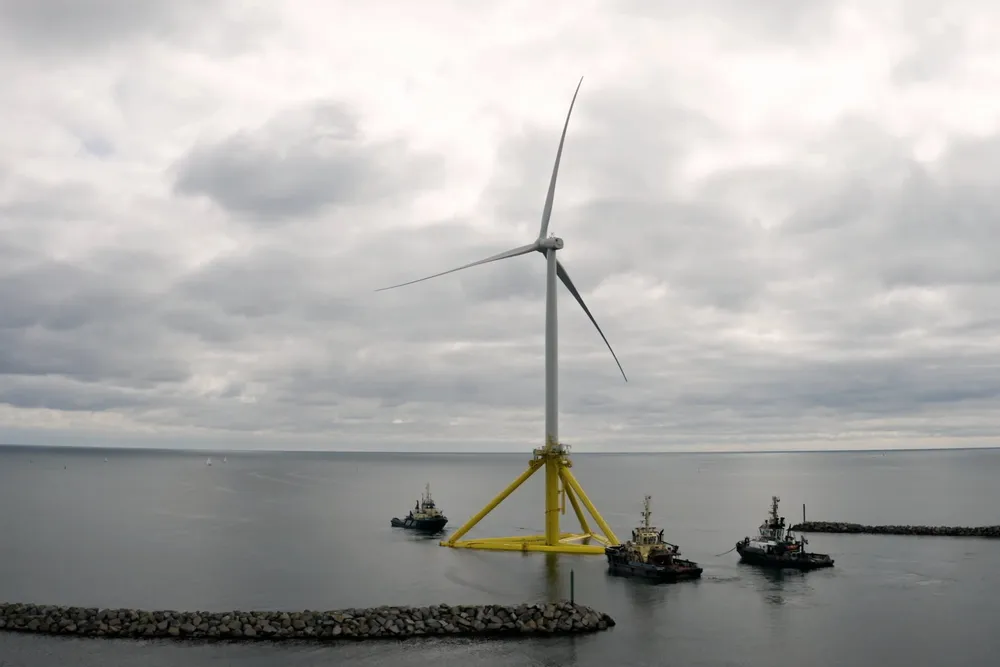Stiesdal eyes ultra-large floating co-op: 'only competition means no survivors'
EXCLUSIVE | Platform technology pioneer also backs scale-up of turbines to 20MW range but says bankers and insurers need reassurance

Floating wind platform specialist Stiesdal Offshore aims to get an ultra-large turbine in the water by the end of 2027 under a collaborative programme it claims can ensure that cut-throat competition doesn't result in “no survivors” in the sector.
Floating Frontrunner – described by Stiesdal Offshore as a joint industry project (JIP) advancing giga-scale floating wind – plans to integrate the Danish group’s own TetraSub platform with a turbine of at least 236-metre rotor size, as it backed the role of large new models as good for floating's viability.
Floating Frontrunner aims to validate as suitable for industrial deployment key technologies such as mooring and cabling, and secure certification in those areas and others like turbine integration, and O&M, assembly and deployment processes.
Stiesdal Offshore hopes the result will be a levelised cost of energy (LCOE) of €100/MWh ($109.40/MWh) – aided by a significant boost to the bankability of floating wind as far as financiers and insurers are concerned.
Key data will be shared among participants in the project, said the company, which like others in the sector now sees large-scale floating wind deployment not kicking in until around 2030, when turbines in the 15MW-plus range will be the norm.
Stiesdal Offshore CEO Peder Nickelsen said the thinking behind Floating Frontrunner is a response to its conclusion that “many players in the floating industry are somehow running in parallel to solve the same problems”.
The need for collaboration, Nickelsen argues, is much greater now because of the massive increase in the size of platforms and turbines that will be used for industrial-scale floating wind.
“We’re seeing continued growth in turbine sizes and with that comes challenges around integration. Many past demonstrators have used hardware that’s only about 20% the size of what we’re working with now. We’ve also seen some negative surprises along the way, which is why, over the past three years, we’ve focused on developing what we call a holistic cost picture – one that captures the full complexity of large-scale floating wind.”
Nickelsen added: “We believe it takes cooperation across the industry to reach cost targets and getting this to fly commercially.”
Elaborating on the specifics, the Stiesdal Offshore chief said the company has managed to reconfigure its TetraSub floater, currently under production at Welcon in Denmark, to work with the very large turbines targeted under Floating Frontrunner.
“We’re also well advanced in our design work with a preferred turbine vendor at the high end of the capacity range.
“We’re planning to test different anchor types and mooring configurations, and we want a certifying body involved early on. The goal is to address open questions – like whether redundancy [provision of back-up capability] is needed in the mooring system – and to build consensus around the answers. That kind of clarity would bring real value to the industry.”
Nickelsen continued: “The main value would be to the developers, to keep Capex and Opex down.
“It doesn’t really matter for the mooring system and O&M if it’s Stiesdal tech – you can use 80% of this also if you select another foundation technology.
The company said that Pentland is one of several sites in northern Europe being considered for Floating Frontrunner
'Transparency to black boxes'
Asked if there is a downside to the collaborative approach by taking the edge off competition in the floating sector, Nickelsen said: “It’s of course it’s extremely important to have competition, but if we only have competition there will be no survivors at the end of the day.
“There needs to be healthy competition, but survival of the fittest needs to be on a system level.
“Our aim is to bring more transparency to areas that have traditionally been black boxes in the industry. It’s not without challenges, but we believe it’s possible to do so without compromising IP or confidentiality.”
Stiesdal Offshore – part of the Stiesdal clean energy technology group founded by wind pioneer Henrik Stiesdal – reckons the JIP demonstration “could bring a lot of value in derisking and answering questions for banks, insurance companies etc. – and ensure that if there are some problems they are weeded out.
“We’d be concerned if some of the larger-scale projects encounter difficulties that cast doubt on the bankability of floating wind. Access to competitive financing is crucial to bringing costs down. Without it, we risk adding an unnecessary premium to project risk.”
Given the challenges that have faced the floating wind over the last few years – not least escalating costs, slippage of projects and even exits from the sector by major developers – Nickelsen says the fact ultra-large turbine models are on the industry’s radar should count as a significant plus.
“That is for us one of the most promising effects on the floating market that the turbine hardware is still increasing, because scaling floating projects becomes significantly more attractive with turbines of that size.
“If we use the newly installed large Siemens Gamesa turbine as a reference we believe we are approaching the flat part of the LCOE curve when it comes to turbine size. That said, turbines below the 236-meter rotor range are clearly still on the steeper part of the curve.”
Nicklelsen said: “The main focus now is still on developing these larger machines. There’s a good chance that 20MW-plus turbines will be available by the time the floating market really picks up, hopefully within the next five years. And when they are, they will drive down costs.
It’s clear we see by far the main challenge for floating wind is to reach a cost level that society can afford.”
(Copyright)